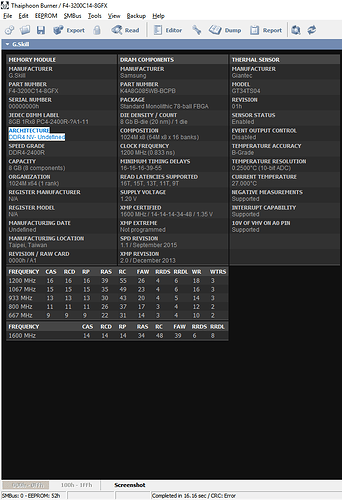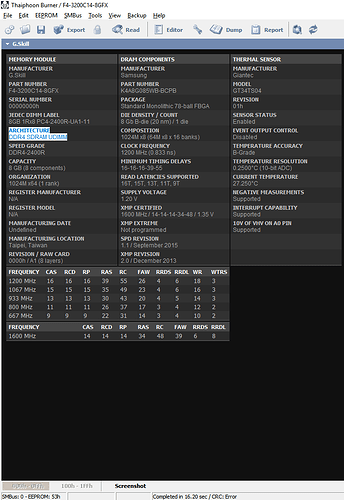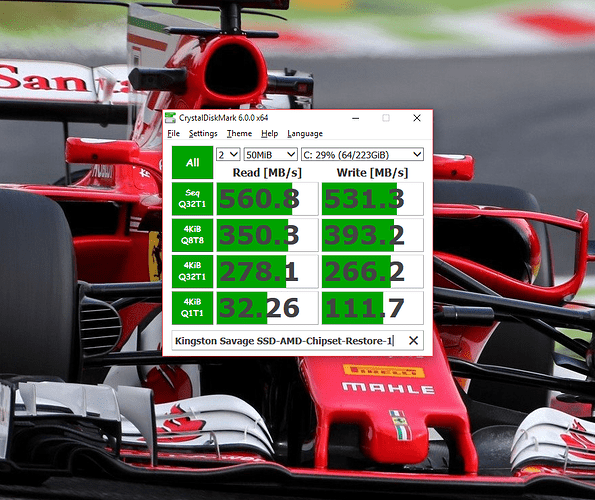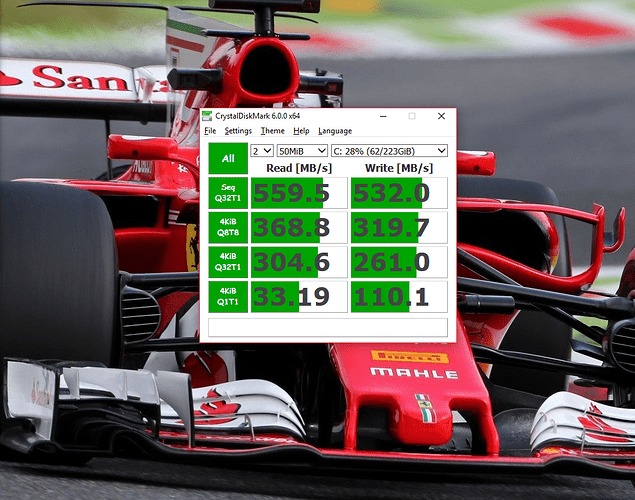Im officially encouraging everyone who sees this thread from the gigashite forums to throw this shit in the bin this includes their shitty intel boards too, and buy asrock, yes asrock the once budget brand are now number 1 for quality in every respect, with kets post i have now seen once again vrm problems twice this week from the gaming 3 and gaming 5, the k7 is not immune either by the way its just as bad. vrms dont just blow, something has caused it, and its the resistors. i hope gigabyte come back with some rock solid boards but that looks highly unlikely im afraid. this is the beginning of the end for this company unless they sort themselves out. Guys pay the extra £20 and buy a quality board forget all this gigabyte shite.
Gaming K5 F22b modded firmware is up
EDIT: Let me know how these firmwares are doing folks, details, screenshots, etc. Can you get better performance with these vs. stock firmware, that kinda thing.
ket, I tried flashing your K7 F22b firmware but I get an “Invalid BIOS image” error in Q-Flash. Since you didn’t include a DOS based flashing utility as part of the download this time, I think most people are going to get stuck and unable to flash.
I could go back to an older firmware download of yours and get the flashing utility from there, but I think I’ll wait until you look into this.
I used a modified version of Efiflash. Worked perfectly. Flashing Gigabyte while avoiding "Invalid BIOS image" (2)
It definitely does not work under Q-flash though.
Whoops I know what I forgot to do there. Fixed now it’ll flash from Q-Flash. Ta for the heads up.
It’s beyond weird!!! How is it posible for RAM Memory to be mistaken for NVM Hybrid or Unknown form factor… RAM is not the same as vNAND or other types of memory device that has nothing to do with SDRAM??? Have a look…
[[File:Screenshot (1024).png|none|auto]] [[File:Screenshot (1025).png|none|auto]]
I’ve tried countless flashbacks to the stock F3 Firmware as it was out of the box… Without any success in restoring the SPD… Typhoon Burner also detects a CRC Error for both modules… I’m gonna try erasing the Main UEFI/BIOS & reprogramming it clean using AFU command line method… Which should do away with any and all residual kinks from Upgrading Firmware… Downgrading firmware… Back and forth… As well as a few soft-bricked flashes… GB is such a pain in the ass when it come down to consistency in following up with their products… They literally just launch a motherboard… with outdated drivers, bloatware, etc… on their support site… And lets not forget their Update Servers are a freaking JOKE… Which rarely ever actually updates according to the Support Site downloads… GB is really falling behind and its a real joke and insult to their "Users/Consumers/GB owners/Etc…
Sorry about going off subject a bit… Now… I’ve been running your F21 Firmware these few days… My hats off to you ket!!! AMD GOP works (Fast Boot & OS Options work as well… UEFI Boot Screen works… Much more stable RAM OC @3400 MHz @1.390V… Ryzen OC stable @3700 MHz @1.296V, SoC @1.114V… Thus a noticeable overall Temp drop… I also clean-installed the latest AMD Chipset Drivers followed by clean-installing my AMD RX-580 with lates WHQL v18.2.1 Adrenalin… And all is quite peachy!!! Awesome work ket!!! I forced the AMD SATA AHCI drivers for both Controllers and I got it back on the spot which fixed the incredibly POOR SSD Performance since AMD doesnt really ever had much interest in developing AHCI Drivers… Either way I’m not exactly sure of the underlying factor that KILLS SSD Performance mainly & SATA-III AHCI Controllers in general… Now though its back to wher its ment to have performed from the start…
[[File:Screenshot (1077).png|none|auto]] [[File:Screenshot (1076).png|none|auto]]
I have an idea that might fix my FlareX SPD problem… First Flashback to Stock F3 Firmware… Set Optimized Defaults ***WITHOUT THE RAM STICKS… Disconnect PSU & CMOS Battery for a little while… Insert Memory to DIMM Slots 2 & 4 first… respectively Slots 1 & 3 too… see if that works… If not… AFU should do the trick all around…
Thanks again for your hard work @ket !!! BTW… The SOC Voltage still defaults @1.2495V !!! I do however change the AUTO to NORMAL (ONLY for SOC Voltage) With no problems at all… I’ll let you know how F22 turns out and if i’m able to fix the SPD issue… AWESOME!!!
Hi Ket do you think the Bios for my MOBO can be modded
its a Gigabyte GA-AB350M-D3H.
Almost certainly but I’m already at capacity with the number of firmwares I’m modding, drivers being modded, and compiling packages with the latest drivers. Someone else would need to step in and agree to pick up on what I don’t have the time for.
It’s beyond weird!!! How is it posible for RAM Memory to be mistaken for NVM Hybrid or Unknown form factor… RAM is not the same as vNAND or other types of memory device that has nothing to do with SDRAM??? Have a look…

I’ve tried countless flashbacks to the stock F3 Firmware as it was out of the box… Without any success in restoring the SPD… Typhoon Burner also detects a CRC Error for both modules… I’m gonna try erasing the Main UEFI/BIOS & reprogramming it clean using AFU command line method… Which should do away with any and all residual kinks from Upgrading Firmware… Downgrading firmware… Back and forth… As well as a few soft-bricked flashes… GB is such a pain in the ass when it come down to consistency in following up with their products… They literally just launch a motherboard… with outdated drivers, bloatware, etc… on their support site… And lets not forget their Update Servers are a freaking JOKE… Which rarely ever actually updates according to the Support Site downloads… GB is really falling behind and its a real joke and insult to their "Users/Consumers/GB owners/Etc…
Sorry about going off subject a bit… Now… I’ve been running your F21 Firmware these few days… My hats off to you ket!!! AMD GOP works (Fast Boot & OS Options work as well… UEFI Boot Screen works… Much more stable RAM OC @3400 MHz @1.390V… Ryzen OC stable @3700 MHz @1.296V, SoC @1.114V… Thus a noticeable overall Temp drop… I also clean-installed the latest AMD Chipset Drivers followed by clean-installing my AMD RX-580 with lates WHQL v18.2.1 Adrenalin… And all is quite peachy!!! Awesome work ket!!! I forced the AMD SATA AHCI drivers for both Controllers and I got it back on the spot which fixed the incredibly POOR SSD Performance since AMD doesnt really ever had much interest in developing AHCI Drivers… Either way I’m not exactly sure of the underlying factor that KILLS SSD Performance mainly & SATA-III AHCI Controllers in general… Now though its back to wher its ment to have performed from the start…

I have an idea that might fix my FlareX SPD problem… First Flashback to Stock F3 Firmware… Set Optimized Defaults ***WITHOUT THE RAM STICKS… Disconnect PSU & CMOS Battery for a little while… Insert Memory to DIMM Slots 2 & 4 first… respectively Slots 1 & 3 too… see if that works… If not… AFU should do the trick all around…
Thanks again for your hard work @ket !!! BTW… The SOC Voltage still defaults @1.2495V !!! I do however change the AUTO to NORMAL (ONLY for SOC Voltage) With no problems at all… I’ll let you know how F22 turns out and if i’m able to fix the SPD issue… AWESOME!!!
Do you have a link to those AHCI drivers? I’ve never been able to find the dame things and unless I’m going blind I don’t see them in the 18.1b chipset drivers. Would you also happen to have a copy of AFUDOS or AFUEFI that works for you? Whenever I try a full erase and reprogram AFUDOS and AFUEFI throws errors at me that vary depending on the version I try. I’ve tried v5.05.04, v4.40, and v2.29 Engineers. None of them work for me
Theres not much I can do about the high SoC voltage when left on the "Auto" setting theres supposed to be an algorithm in place to intelligently increase the SoC voltage as needed based on other settings but it does not appear GB have that in place at all it just bangs right up to 1.248v which is absurd. I don’t even need that when I push to 3600MHz and beyond on my RAM, 1.15v at most.
Hi,
Also interested in the last AHCI Drivers and USB, most of them I found them here in this forum:
Recommended AHCI/RAID and NVMe Drivers
USB 3.0/3.1 Drivers (original and modded)
But if someone found new ones I will be happy! ![]()
P.S: Also tried the last package 18.1b but some of them revert to Microsoft drivers!!?!?!?!
Drivers that have been messed with can be a risky business, amd nvidia and microsoft are all in partnership together to provide WHQL drivers that have been thoroughly tested prior to release, if you do any important work on your machine i would strongly advise against installing them, if the driver gets reverted back to the microsoft versions they have problems, of course its your machine.
Yeah, but I am never sure what drivers to use, Microsoft or AMD ones, even from chipset 18.1b some of them do not install, I have to go directly to device manager and browse to the directory of the extraction "C:\AMD" so they can install and update properly. All AMD drivers look outdated compared to Microsoft ones, which is best? I have no clue.
WHQL drivers are not thoroughly tested, if they install without error thats good enough for the Quality Labs ![]() Theres countless occasions where WHQL drivers are worse than beta drivers because the WHQL adds a delay in the release of the driver.
Theres countless occasions where WHQL drivers are worse than beta drivers because the WHQL adds a delay in the release of the driver.
Microsoft provide generic drivers that just allows the hardware to function in most cases, where drivers from the manufacturer have been more optimised and typically will have more features. The only time its worth going with a generic MS driver is if the hardware you have is old and obsolete (and even then you should probably try the latest driver the manufacturer released).
Hi ket,
I have been following this thread for a while now, but have not tried your modded BIOS yet on my Gaming 5. Unfortunately the one major issue I do have with it cannot be fixed by a BIOS fix. I am unlucky to have a Sound Blaster Z sound card, so I always have to discharge my motherboard every time I start up my PC. Other than that, the board has given me minimal issues, so I have stayed on BIOS version F9/F10 for now.
I’d like to ask your opinion on following the advice of several people here in getting an AsRock Taichi, given that it does not have dual BIOS. I am surprised that not every manufacturer has dual BIOS by now, and I am a bit concerned in getting it and then having to update the BIOS. Is there another way to recover from a failed BIOS update on a Taichi? I also see that the X470 Taichi can be found on the AsRock website, so I will wait until that is available. Would it be safe to assume that the new one would also be of the better quality compared to Gigabyte? I am also hoping the VRM quality and cooling will be better, as I had to mount a RAM cooler over my VRM heatsinks to maintain reasonable temperatures while overclocking.
Thanks for your time, and for the effort you have put into these modded BIOSes.
I do occasionally prod my contacts at Asrock about adding dual ROM chips to their boards but I can say for Asrock at least you need not fear updating the firmware they easily have the most rigorous bug testing before releasing any new firmware so a bricked board due to a bad update isn’t something you need to particularly worry about. As for recovery methods I do believe the Taichi has a flashback method which while not as reliable as an actual backup ROM chip should service 95% of bad flash scenarios. The Aorus boards however like to soft brick their firmware just because they feel like it, not something I’ve really run in to myself but countless other people have. In terms of cooling, voltage stability, etc the Taichi is night and day difference compared to any Aorus board. Even the Asrock very much value geared Fatal1ty K4 board I have has substantially more stable voltage readings than the Gaming 5 I have does.
As for those horrible VRM temps on the Gaming 5 invest in some Laird 6w/mk thermal pads, remove the plastic shroud over the VRM heatsink and remove the terrible plastic standoffs from the VRM heatsinks and replace them with rubber washers. This will allow substantially better thermal contact, heat transfer and dissipation which will lead to much better temps. Currently sitting here using the lemon Gaming 5 while I make the modded firmware while running SETI@Home as well as milkyway@home scientific projects, the CPU @ 3.85GHz 1.35v the VRMs are not getting hotter than 66c with an ambient temp of 24.6c and thats with everything cased up as well not an open test bench. Stock mounting and thermal pads for the Gaming 5 are extremely poor, under the same conditions I would be surprised if someone were under 80c VRM temp.
Modded version of F22b is up for the X370 Gaming K3
K7 F22b seems as stable as F21.
Main difference is my RAM now does 14-15-15-15-40 at 1.415V and 3360Mhz (33.33, BCLK 100.80) as opposed to 16-16-16-16-36 at 3333Mhz, before. Transfer speeds are improved ~6% compared to my initial 3426Mhz at 16-18-18-18-36. In short, read speed is up from 484xxMB/s to 514xxMB/s and latency is down from 72.0ns to 69.6ns
Not bad, considering I’ve mixed two 2x8GB kits.
CPU acts the same, though V-droop seems a bit worse (-0.010 to -0.013V w/LLC Extreme under Prime95)
I won’t be testing any auto voltages, sorry. Not after the one time my CPU started asking for 1.5xxV, lol.
Layout looks good. It would be nice to see the memory speed while messing with BCLK, though.
All functionality seems good.
Hi Ket,
In your opinion which BIOS version is the best the X370 Gaming 5 F22bM-D or the F9fM-D??
I am asking because I am gonna keep AMD Ryzen 1600x for a while, I don’t intend to upgrade to 2XXX series.
I do occasionally prod my contacts at Asrock about adding dual ROM chips to their boards but I can say for Asrock at least you need not fear updating the firmware they easily have the most rigorous bug testing before releasing any new firmware so a bricked board due to a bad update isn’t something you need to particularly worry about. As for recovery methods I do believe the Taichi has a flashback method which while not as reliable as an actual backup ROM chip should service 95% of bad flash scenarios. The Aorus boards however like to soft brick their firmware just because they feel like it, not something I’ve really run in to myself but countless other people have. In terms of cooling, voltage stability, etc the Taichi is night and day difference compared to any Aorus board. Even the Asrock very much value geared Fatal1ty K4 board I have has substantially more stable voltage readings than the Gaming 5 I have does.
As for those horrible VRM temps on the Gaming 5 invest in some Laird 6w/mk thermal pads, remove the plastic shroud over the VRM heatsink and remove the terrible plastic standoffs from the VRM heatsinks and replace them with rubber washers. This will allow substantially better thermal contact, heat transfer and dissipation which will lead to much better temps. Currently sitting here using the lemon Gaming 5 while I make the modded firmware while running SETI@Home as well as milkyway@home scientific projects, the CPU @ 3.85GHz 1.35v the VRMs are not getting hotter than 66c with an ambient temp of 24.6c and thats with everything cased up as well not an open test bench. Stock mounting and thermal pads for the Gaming 5 are extremely poor, under the same conditions I would be surprised if someone were under 80c VRM temp.
Thanks for the advice. I did consider the VRM heatsink mods you suggested, I even got some thermal pads from AliExpress (I live in Namibia, so I couldn’t find the brand you suggested), but decided against it as I wanted to try and have the hardware mods done by Gigabyte to fix the sound card issue, but after several months they told me they had to send it back to Asia to fix it, which would take another month or two, so I just gave up. Removing the plastic shroud and using the RAM cooler keeps the temps under 80 (maybe even under 70) when running Prime95, so that was enough for me.
Would you also recommend AsRock above Asus? I am not looking for necessarily massive overclocks, just around 3.8 or 3.9GHz on my 1700x, but I am looking for stability. I have always bought Gigabyte motherboards in the past, but after seeing the lack of support for this platform, I think it is time to explore the other brands.
One last question: I see the Taichi has a 8 pin and also a 4 pin power plug, but my current PSU only has one 8 pin. Will the motherboard work if I only plug in the 8 pin? Should I get a converter from Molex to 4 pin and use that? Or will I need a whole new PSU just to be able to switch to AsRock/Asus?
I do occasionally prod my contacts at Asrock about adding dual ROM chips to their boards but I can say for Asrock at least you need not fear updating the firmware they easily have the most rigorous bug testing before releasing any new firmware so a bricked board due to a bad update isn’t something you need to particularly worry about. As for recovery methods I do believe the Taichi has a flashback method which while not as reliable as an actual backup ROM chip should service 95% of bad flash scenarios. The Aorus boards however like to soft brick their firmware just because they feel like it, not something I’ve really run in to myself but countless other people have. In terms of cooling, voltage stability, etc the Taichi is night and day difference compared to any Aorus board. Even the Asrock very much value geared Fatal1ty K4 board I have has substantially more stable voltage readings than the Gaming 5 I have does.
As for those horrible VRM temps on the Gaming 5 invest in some Laird 6w/mk thermal pads, remove the plastic shroud over the VRM heatsink and remove the terrible plastic standoffs from the VRM heatsinks and replace them with rubber washers. This will allow substantially better thermal contact, heat transfer and dissipation which will lead to much better temps. Currently sitting here using the lemon Gaming 5 while I make the modded firmware while running SETI@Home as well as milkyway@home scientific projects, the CPU @ 3.85GHz 1.35v the VRMs are not getting hotter than 66c with an ambient temp of 24.6c and thats with everything cased up as well not an open test bench. Stock mounting and thermal pads for the Gaming 5 are extremely poor, under the same conditions I would be surprised if someone were under 80c VRM temp.
Thanks for the advice. I did consider the VRM heatsink mods you suggested, I even got some thermal pads from AliExpress (I live in Namibia, so I couldn’t find the brand you suggested), but decided against it as I wanted to try and have the hardware mods done by Gigabyte to fix the sound card issue, but after several months they told me they had to send it back to Asia to fix it, which would take another month or two, so I just gave up. Removing the plastic shroud and using the RAM cooler keeps the temps under 80 (maybe even under 70) when running Prime95, so that was enough for me.
Would you also recommend AsRock above Asus? I am not looking for necessarily massive overclocks, just around 3.8 or 3.9GHz on my 1700x, but I am looking for stability. I have always bought Gigabyte motherboards in the past, but after seeing the lack of support for this platform, I think it is time to explore the other brands.
One last question: I see the Taichi has a 8 pin and also a 4 pin power plug, but my current PSU only has one 8 pin. Will the motherboard work if I only plug in the 8 pin? Should I get a converter from Molex to 4 pin and use that? Or will I need a whole new PSU just to be able to switch to AsRock/Asus?
I’d say Asrock have better support and manufactring quality is better as well compared to Asus so they would be my first choice. The extra 4 pin CPU connection is only to help deliver cleaner power when overclocking it’s not necessary to have anything plugged in to it.
Good to know, I bet if CLDO_VDDP were available you would be able to go higher. I’ll maybe look in to bringing that option back for the K7 and Gaming 5 it depends how much love I want to show to the boards I’m getting really sick of fixing GBs firmware.
F9f and F22b are fairly equal for me I’d say F9f that CLDO_VDDP option is worth a lot to any serious overclocker.
@ket You’ve done plenty of Gigabyte’s work. That one function might bring me another 2-4% memory performance on average so unless it becomes absolutely necessary for some other reason I’d let Gigabyte do their job. Unless of course they start sending you money, lol.
Over-all, I’m completely happy with what you’ve done and you should be as well. My main concern is the increased V-droop which is hardly your fault and all I’ve had to do is increase Vcore a notch. With absolutely no consqeuence towards the CPU max temp, I might add. VRM still stays below 70C so nothing’s bad per sé, although still not good enough on Gigabyte’s part.
Something tells me my ICM doesn’t like clocking RAM much higher. Even ridiculously loose timings and 1.45V+ won’t allow the 3466Mhz my RAM are rated at. 3400Mhz plus a tad is possible with XMP-settings but this means seriously sad secondary timings and I’ve failed at tightening them at this speed. If I bump BCLK to 101Mhz (3366Mhz RAM), Windows crashes HARD as soon as I pull a memory load beyond the startup. TL;DR I think I’m at my system’s limit.



